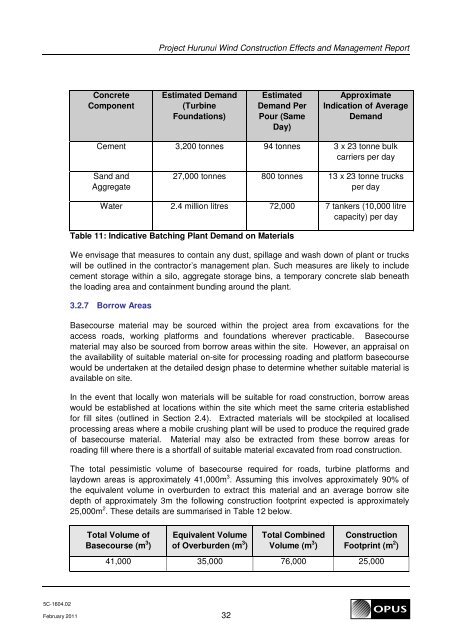Project Hurunui Wind Construction and Project Overview
Project Hurunui Wind Construction and Project Overview
Project Hurunui Wind Construction and Project Overview
Create successful ePaper yourself
Turn your PDF publications into a flip-book with our unique Google optimized e-Paper software.
<strong>Project</strong> <strong>Hurunui</strong> <strong>Wind</strong> <strong>Construction</strong> Effects <strong>and</strong> Management Report<br />
Concrete<br />
Component<br />
Estimated Dem<strong>and</strong><br />
(Turbine<br />
Foundations)<br />
Estimated<br />
Dem<strong>and</strong> Per<br />
Pour (Same<br />
Day)<br />
Approximate<br />
Indication of Average<br />
Dem<strong>and</strong><br />
Cement 3,200 tonnes 94 tonnes 3 x 23 tonne bulk<br />
carriers per day<br />
S<strong>and</strong> <strong>and</strong><br />
Aggregate<br />
27,000 tonnes 800 tonnes 13 x 23 tonne trucks<br />
per day<br />
Water 2.4 million litres 72,000 7 tankers (10,000 litre<br />
capacity) per day<br />
Table 11: Indicative Batching Plant Dem<strong>and</strong> on Materials<br />
We envisage that measures to contain any dust, spillage <strong>and</strong> wash down of plant or trucks<br />
will be outlined in the contractor’s management plan. Such measures are likely to include<br />
cement storage within a silo, aggregate storage bins, a temporary concrete slab beneath<br />
the loading area <strong>and</strong> containment bunding around the plant.<br />
3.2.7 Borrow Areas<br />
Basecourse material may be sourced within the project area from excavations for the<br />
access roads, working platforms <strong>and</strong> foundations wherever practicable. Basecourse<br />
material may also be sourced from borrow areas within the site. However, an appraisal on<br />
the availability of suitable material on-site for processing roading <strong>and</strong> platform basecourse<br />
would be undertaken at the detailed design phase to determine whether suitable material is<br />
available on site.<br />
In the event that locally won materials will be suitable for road construction, borrow areas<br />
would be established at locations within the site which meet the same criteria established<br />
for fill sites (outlined in Section 2.4). Extracted materials will be stockpiled at localised<br />
processing areas where a mobile crushing plant will be used to produce the required grade<br />
of basecourse material. Material may also be extracted from these borrow areas for<br />
roading fill where there is a shortfall of suitable material excavated from road construction.<br />
The total pessimistic volume of basecourse required for roads, turbine platforms <strong>and</strong><br />
laydown areas is approximately 41,000m 3 . Assuming this involves approximately 90% of<br />
the equivalent volume in overburden to extract this material <strong>and</strong> an average borrow site<br />
depth of approximately 3m the following construction footprint expected is approximately<br />
25,000m 2 . These details are summarised in Table 12 below.<br />
Total Volume of<br />
Basecourse (m 3 )<br />
Equivalent Volume<br />
of Overburden (m 3 )<br />
Total Combined<br />
Volume (m 3 )<br />
<strong>Construction</strong><br />
Footprint (m 2 )<br />
41,000 35,000 76,000 25,000<br />
5C-1604.02<br />
February 2011 32
















